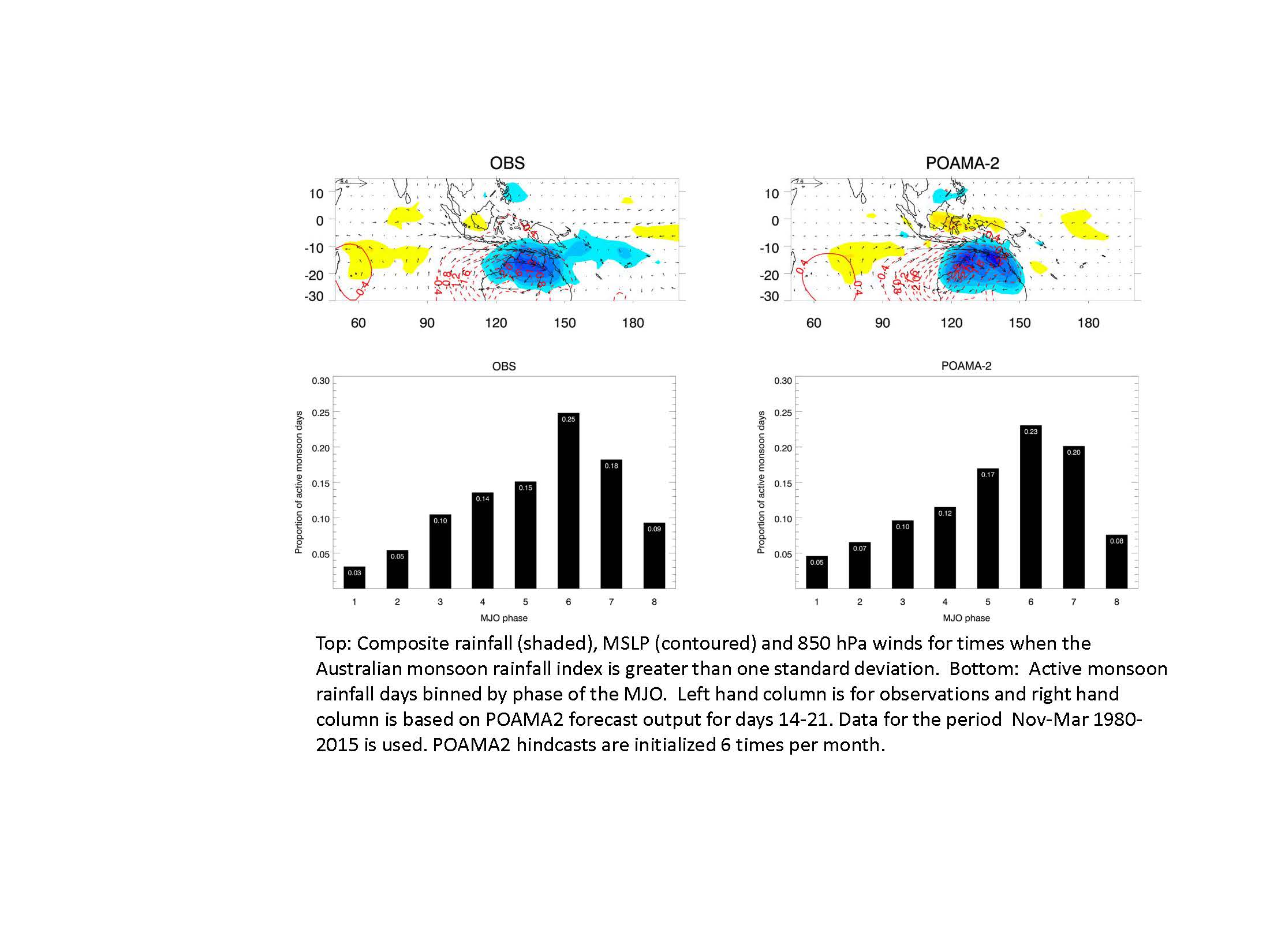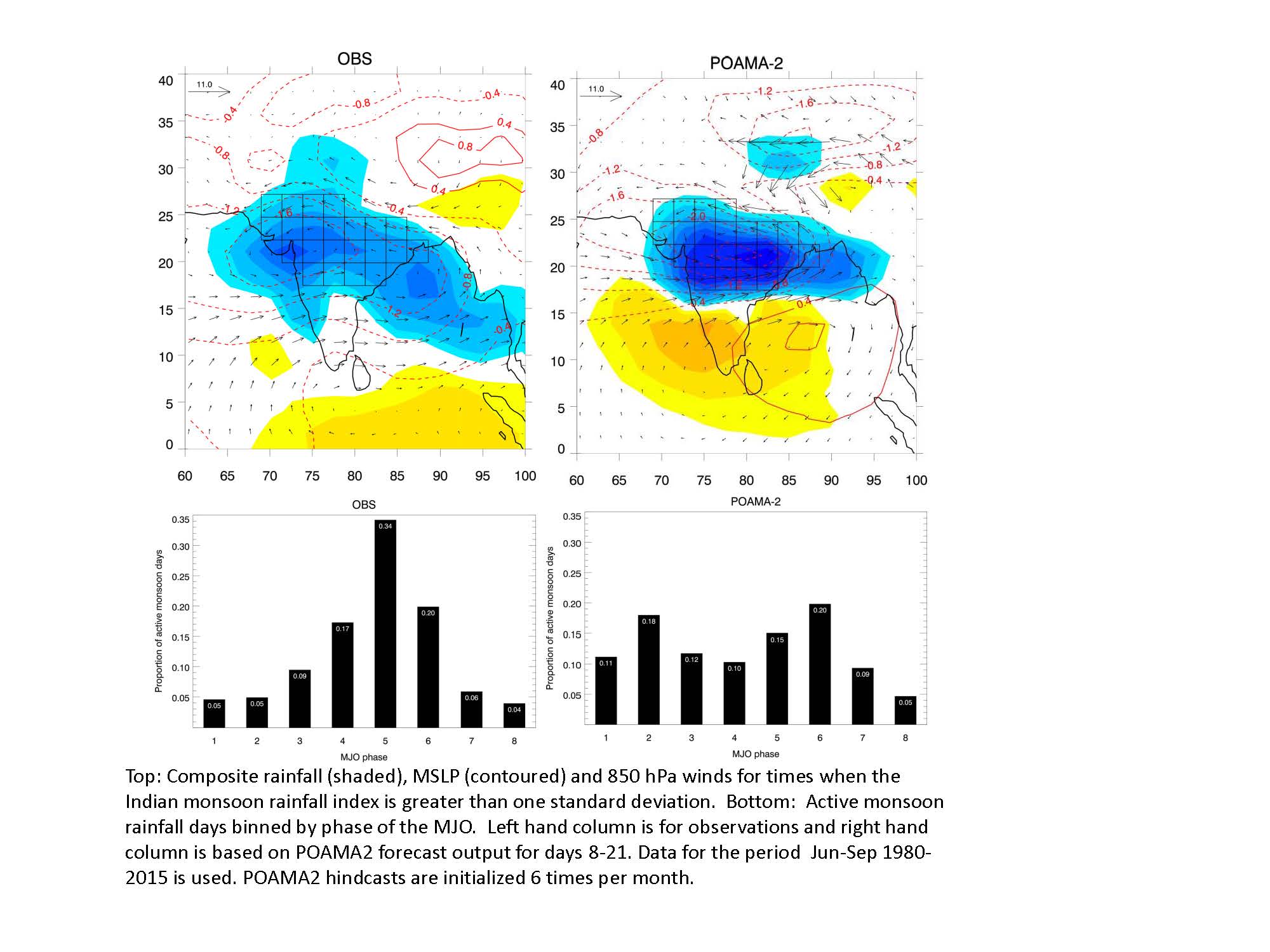- Main.WebHome
- Monsoon Sub-Project
Monsoon Sub-Project
2S Monsoon Sub-project
Members:
Harry Hendon and Andrew Marshall (BoM Australia)
A.K. Sahai (IITM India)
Bin Wang (U Hawaii)
Alice Grimm (Federal University of Parana, Brazil)
Introduction
Monsoons vary strongly at intraseasonal time scales and these variations have strong societal impacts such as on agriculture, water resource management, transportation, and health. The S2S project affords the opportunity to assess current capability to predict active-break episodes of the monsoons with lead times to ~ 6 weeks.
Much of the monsoon intraseasonal variability is contributed by the MJO and its northern summer counterpart (the MISO), hence multiweek prediction of the monsoons should be feasible because of the capability to predict the MJO to lead times ~4 weeks. Together with an assessment of forecast skill for monsoon rainfall, assessing the S2S forecast model's capability to predict the MJO and MISO and to simulate modulation of the monsoons by the MJO and MISO will provide insight into potential model shortcomings that may be limiting predictive skill.
A project plan for the S2S Monsoon Sub-Project has been developed and is available . We envision there will be close collaboration with the Asian-Australian Monsoon Working Group (http://www.clivar.org/asian-australian-monsoon), under the CLIVAR-GEWEX Monsoon panel, who will assist to promote evaluation of monsoon forecast skill using the full range of S2S models.
A summary of the project plan and progress to date is given below:
Project Work Plan and Progress to Date
The key objectives and deliverables of the first phase of the Monsoon Sub-Project are:
1) Development of a set of intraseasonal forecast products/metrics that are applicable to all of the major monsoon systems and which can be maintained, monitored, and verified with S2S near-real time and hindcast archives
2) Provision of some demonstration forecast products that can be produced and monitored in real time at NMC
3) Provision of the multiweek forecast skill for various monsoons based on hindcast evaluation. Results will be presented in scientific publications
4) Assessment of monsoon intraseasonal predictability across all key monsoon systems
In order to assess monsoon predictions using the S2S models, a set of monsoon forecast products and metrics are required that will facilitate monitoring and assessment of predictions of monsoon variations, especially active and break episodes. The metrics should specifically target monsoon intraseasonal variability and be amenable to application to (multi-model) ensemble prediction systems for which forecast products will necessarily be presented as shifts in background probabilities.
Many NMC maintain their own set of monsoon forecast products but a unified/seamless approach is typically lacking and there are very few available prediction products that target multiweek ensemble (probabilistic) prediction. The initial target for the forecast products will be rainfall and zonal wind (e.g., monsoonal westerlies), especially the extreme occurrences on ~weekly time scales. The forecast metrics will necessarily target dynamical linkages so as to provide insight into model error. These new forecast products and metrics can be used both as part of a seamless prediction system (eg tying in with the Severe Weather Forecasting Demonstration project that target predictions to 5 days) and also to monitor and evaluate forecast model performance for depiction of monsoon intraseasonal variability.
It is envisioned that the Asian-Australian Monsoon Working Group monsoon panel can play a coordinating role for developing the metrics/products with a necessarily unified approach across all key monsoon systems. To date, metrics for the Australian summer monsoon, based area mean rainfall and U850 across northern Australia as described in Marshall and Hendon (2015), and for the Indian summer monsoon, based on mean rainfall over the "core monsoon zone" as described by Rajeevan et al. (2010), have been produced for the historical record and are maintained in near real time here.
Marshall and Hendon (2015) assessed the predictive skill for active/break rainfall episodes in the Australian summer monsoon using the hindcasts from the BoM POAMA model, which is part of the S2S data base. They also showed that active rainfall episodes are ~8 times more likely to occur in phases 6-7 of the MJO than in phases 1-2. They further showed THe POAMA2 model (included in S2S archive) faithfully captures the modulation of monsoon rainfall by the MJO. Monsoon rainfall prediction with POAMA2 was found to be skillful to about 2 weeks lead time. New evaluation of the ACCESS-S model , based on the UKMO GC2 model that is the same used in the GloSea5 model that contributes to S2S, shows improved skill over the POAMA model by at least 1 week.

A similar analysis of the role for the MJO for modulating the Indian summer monsoon rainfall has also been done. Active rainfall occurs in phase 5 and suppressed in phases 8-1. In contrast to the Australian summer monsoon, the POAMA-2 model is not able to capture the modulation of Indian summer monsoon rainfall by the MJO, suggesting the rainfall forecasts for the Indian Monsoon are limited by the model's inability to faithfully reproduce the impacts of the MJO in the monsoon.

The key objectives and deliverables of the second phase of the project, which will focus on monsoon onset, are:
1) Compilation of monsoon onset every year spanning the S2S/ISVHE/CHFP data base for each of the main monsoon regions and identification of key process associated with onset each year. Dates will be updated and served on the S2S web page.
2) Evaluation of the multiweek forecast skill to predict onset for each monsoon using the multi-model ensemble
3) Assessment of the representation of monsoon onset in the forecast models so as to guide forecast model development
4) Scientific papers on predictability and predictive skill of onset, including the underlying source of predictability and mechanism of onset and its representation in forecast models.
The monsoon rainfall indices for Australia and India, for 1980-present, are available
Australian and Indian Monsoon Indices, updated in realtime at the Australian Bureau of Meteorology (follow link under Project Specific Products).
References:
Marshall and Hendon (2015) manuscript on Subseasonal Prediction of Australian Summer Monsoon Anomalies in POAMA and the role of the MJO.
